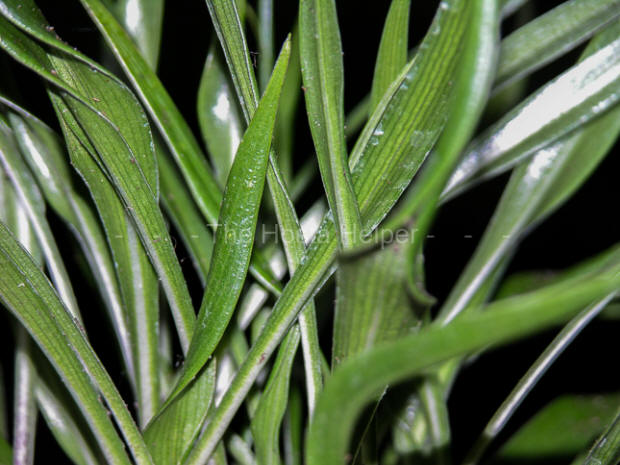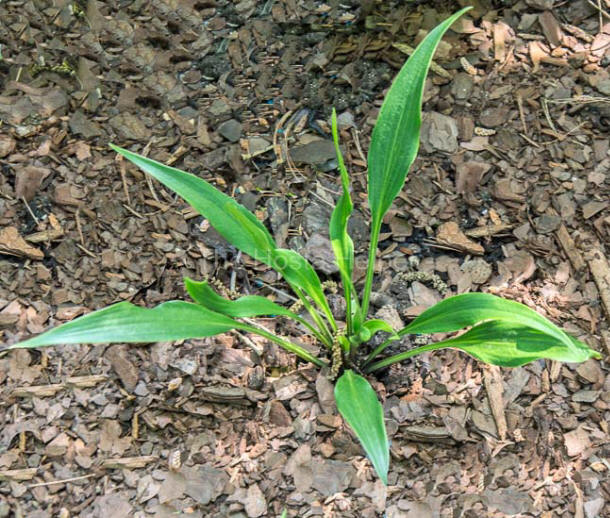|
  This is a small size sport of H. 'Tardiflora' from
Dr. Fumio Maekawa of
Japan that was registered by
The American Hosta Society on his behalf
in 2002. It grows 8 inches high by 17 inches wide with very
narrow elliptic or lanceolate shape leaves that are contorted, have rough texture
and thick substance. The pale bluish lavender flowers bloom in
September followed by viable seeds. This is a small size sport of H. 'Tardiflora' from
Dr. Fumio Maekawa of
Japan that was registered by
The American Hosta Society on his behalf
in 2002. It grows 8 inches high by 17 inches wide with very
narrow elliptic or lanceolate shape leaves that are contorted, have rough texture
and thick substance. The pale bluish lavender flowers bloom in
September followed by viable seeds.
 According to
The Hostapedia by Mark Zilis (2009), "...has probably existed
for more than seventy years, it still draws the attention of
hostaphiles for its contorted foliage...it reverts to 'Tardiflora'
when propagated by
tissue culture... it was thought that
seedlings of 'Tortifrons' did not inherit its twisted nature,
but Bob Solberg of Green Hill Farm in North Carolina proved everybody wrong with 'Corkscrew'." According to
The Hostapedia by Mark Zilis (2009), "...has probably existed
for more than seventy years, it still draws the attention of
hostaphiles for its contorted foliage...it reverts to 'Tardiflora'
when propagated by
tissue culture... it was thought that
seedlings of 'Tortifrons' did not inherit its twisted nature,
but Bob Solberg of Green Hill Farm in North Carolina proved everybody wrong with 'Corkscrew'."
The New Encyclopedia of Hostas by
Diana
Grenfell (2009) states in its Hosta Hybrids for Connoisseurs chapter: "Slow
to increase. Cannot be successfully reproduced by
micro-propagation (tissue
culture), so it
remains a rarity...The narrow, distorted leaves are held erect and have a
distinct twist caused by an aberration in the make-up of the skin cells."
 Nomenclature changes recommended in the
1991 book The
Genus Hosta by
W. George Schmid and accepted by The American
Hosta Society would update names as follows:
H. tortifrons is now H. 'Tortifrons'
and H. tardiflora is H. 'Tardiflora'. Nomenclature changes recommended in the
1991 book The
Genus Hosta by
W. George Schmid and accepted by The American
Hosta Society would update names as follows:
H. tortifrons is now H. 'Tortifrons'
and H. tardiflora is H. 'Tardiflora'.


An article about Fall Bloomers by
Herb Benedict and
Jim Wilkins in
The
Hosta Journal (1991 Vol. 22 No. 1) states that, "Here
are some of the fall blooming plants we grow...(listed in the order of bloom
times in Michigan).
| 1) H. kikutii
|
A medium size plant densely flowering
with white blooms. The flowers are equally arranged around the
central axis of the raceme so that the bloom scapes resembles a
bottle brush or pony tail...We are growing two named varieties,
'Hirao-59' and 'Finlandia'. |
| 2) H. 'Fall Bouquet' |
Small, green plant, leaves slightly
undulated, lavender scape and blooms, floriferous. |
| 3) H. longipes |
Small green plant, densely flowering
with a tall stiff bloom scape. The flowers are lavender and the
leaves are green. |
| 4) H. gracillima |
Funnel-shaped, light lavender flowers.
A miniature green plant, with shiny surface. |
| 5) H. 'Iwa
Soules' |
Iwa means rock, and this plant was
imported by Marjorie Soules, from Japan. It is a small green plant
with lavender flowers. |
| 6) H. tortifrons |
In the same section (Picnolepis) as
H. longipes and
H. rupifraga. Distinctive small plant, with twisted
green leaves and lavender flowers. |
| 7) H. 'Fused Veins' |
Small, green leaves often with ╝ inch
margin which is a lighter green. The lance shaped leaves are
undulated and the veins come together regularly. The flowers are
mauve and the scape is sometimes branched. |
| 8) H. rupifraga |
Small, medium green, with thick,
leathery, ovate leaves. Densely flowering with purple flowers.
'Urajiro', 'Grand Slam', 'Maruba Iwa' |
| 9) H. tardiflora (now H. 'Tardiflora') |
This small hosta is the last to bloom
for us. Its leaves are shiny, dark green and lance shaped. The
flowers are light lavender and borne in abundance on 12 inch scapes. |



 In an article in
The
Hosta Journal (2001 Vol. 32 No. 1),
Tom Micheletti,
former President of The American Hosta Society took on the task of listing the
"Classic Hosta Cultivars" through the year 2003. He decided to divide these into
categories including: Green,
Blue,
Yellow (Gold,
White-Margined,
Yellow-Margined,
White Medio-Variegated
and Yellow Medio-Variegated. In an article in
The
Hosta Journal (2001 Vol. 32 No. 1),
Tom Micheletti,
former President of The American Hosta Society took on the task of listing the
"Classic Hosta Cultivars" through the year 2003. He decided to divide these into
categories including: Green,
Blue,
Yellow (Gold,
White-Margined,
Yellow-Margined,
White Medio-Variegated
and Yellow Medio-Variegated.
|
Of course all species of hosta are
green, and they are all classics. Those that are readily available
to gardeners are: H. longipes,
H. kikutii,
H. montana,
H. plantaginea, H. ventricosa,
H. venusta and
H. yingeri. |
| Classic
Green Hostas |
- H. 'Candy Hearts' has dark-green heart-shaped leaves.
- H. 'Donahue Piecrust' is one of the best piecrust-margined
hostas.
- H. 'Fortunei Hyacinthina' is the precursor to many sports.
- H. 'Green Fountain' has long pointed flowing leaves.
- H. 'Joseph', if you want shiny dark-green leaves, this the
plant for you. It has masses of lavender flowers to boot!
- H. 'Hirao Majesty',
H. 'Hirao Splendor' and
H. 'Hirao
Supreme' are each distinctive.
- H. 'Honeybells' is one of the first fragrant hybrid hostas.
- H. 'Invincible' is not indestructible, but very distinctive
with shiny dark-green leaves and large fragrant flowers.
- H. 'Lakeside Black Satin' is noted for every dark-green
satiny leaves.
- H. 'Lancifolia' is probably the most widely grown hosta.
|
- H. 'Leather Sheen' has dark-green leathery leaves.
- H. 'Maraschino Cherry' is another dark-green, but just wait
till the flowers appear in late summer on dark, cherry red
petioles!
- H. 'Elatior' is the one, if you like big hostas. There are a
couple of look-alikes, but this one's flowers grow straight up
rather than sideway from the plant.
- H. 'Pearl Lake' is an old time blue green that has staying
power.
- H.
'Regal Rhubarb' is one of the first hybrids to have red
petioles.
- H. 'Royal Standard' -- who can fault this plain green,
sun-tolerant hosta in late summer when masses of pure white
fragrant flowers appear?
- H. 'Second Wind' is a plain green sport of a popular
variegated plant, but distinctive and showy in its own right.
- H. 'Sparkling Burgundy' is another green with delightful
flowers and red stems.
- H. 'Tortifrons' is like no other hosta!
- H. 'Undulata
Erromena' is the green sport of the
white-margined hosta that Grandma grew.
|
|
This is quite an extensive list of
distinctive cultivars. Many have been popular either with gardeners,
landscapers and collectors for over 25 years...Their timeless beauty
is why they are still kicking after all these years. |



 An article in
The
Hosta Journal (2002 Vol. 33 No. 1) reporting on a speech
by Barry Yinger at the 2001
National
Convention of The
American Hosta Society says, "The Japanese take a different
approach to hosta breeding than the Americans, creating some exciting new
results. Native species, which look ugly or "peculiar" at best in the wild, are
used in many Japanese hybrids, resulting in spectacular new varieties. H. 'Tortifrons'
(noted for its very twisted, grass-like foliage), used in many Japanese hybrids,
impairs a twist to the leaves of its offspring. One example given was H. 'Tatsumaki',
meaning "tornado" which has large twisted leaves and attractive flowers." An article in
The
Hosta Journal (2002 Vol. 33 No. 1) reporting on a speech
by Barry Yinger at the 2001
National
Convention of The
American Hosta Society says, "The Japanese take a different
approach to hosta breeding than the Americans, creating some exciting new
results. Native species, which look ugly or "peculiar" at best in the wild, are
used in many Japanese hybrids, resulting in spectacular new varieties. H. 'Tortifrons'
(noted for its very twisted, grass-like foliage), used in many Japanese hybrids,
impairs a twist to the leaves of its offspring. One example given was H. 'Tatsumaki',
meaning "tornado" which has large twisted leaves and attractive flowers."

W. George Schmid in
The
Hosta Journal (2009 Vol. 40 No. 2) states that, "...'Tortifrons'.
This is yet another of the "difficult ones."...We think 'Tortifrons' was
originally found as a wild sport. It has been in Japanese cultivation for many
years but it has never been located in the wild.






|



